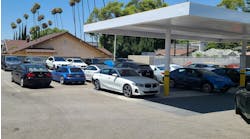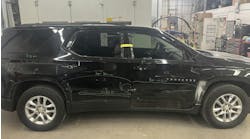Taking the guesswork out of measuring
So your shop has been using the traditional frame gauge and tram bar for structural dimensioning and consideration of a new, computerized three-dimensional system comes up. Let’s look at the big picture before we look at the nuts and bolts of these systems.
First, let’s look at the expenditure in relation to ROI basis. It’s difficult to place a value on documentation and is perhaps easier to evaluate what happens without it. With the proper documentation, your charges for repairs completed will be justified by an accurate report of all the damage. Let’s put opinion and guesswork away and raise the bar on our level of professionalism. That’s not to say that you couldn’t hang traditional frame gauges on and compile a report, but the printout will carry more weight than a handwritten document. Three-dimensional systems are also more thorough and will always verify deflection and inertia damage that may have been otherwise overlooked. Proof of finalized structural dimensions is priceless in regard to any repair issues that can arise after the repair is completed.
Now let’s look at it from a technician’s point of view. The way to make time on structural repairs is to do it right the first time. Reversing the damaged area in the manner in which it traveled is paramount. Have you ever made a pull or two only to be surprised by additional damage you didn’t count on? Multiple pulls and reversing complete areas will save dimensioning time in the end. With electronic measuring you can watch the area move on the dimension screen and determine if the pull is set up correctly by the results. I purchased my first system in 1994 with some apprehension. “Will the system lie to me?” was a concern I had. I spent the first month double-checking the secondary damage, which I previously seldom repaired, blaming it on normal, poor build quality. I was also concerned that I would spend too much time making it “perfect.” The truth is that I gained time up front by never pulling incorrectly since the live readings really make the pulling process a no-brainer. I then invested extra time near the end of repair to make it perfect. Perhaps an even wash at overall, but my level of professionalism and finished product changed as a result. I also was able to accurately identify, estimate and verify damage to receive proper compensation. Bottom line—don’t be intimidated; this technology is the best tool you will ever use during structural repair.
Due to patent issues, all systems vary in the technology used to accomplish dimensioning. All three-dimensional systems work in a similar manner by establishing a datum plane under the vehicle, and most give a detailed report on each location measured, which includes length, height and width. Datum plane is best described as an imaginary flat line drawn under the vehicle used to measure heights. It duplicates the factory platform allowing differences in height to be determined. We establish datum when using traditional gauges by purchasing dimension manuals for information and measuring down from each area the gauges hang.
All systems will establish a base to measure from. The center section of the vehicle is where we usually will find “primary build” measuring locations accompanied by the four “torque box” areas. Torque box areas are where the front and rear rails are tied into the rocker areas. Because these areas also tie upward into the pillars, this is the strongest area of the vehicle and will remain undamaged longer than the end sections that are designed to collapse. Measurement deviations in the base area are divided up to establish the most accurate datum and centerline. Length is established by using a “primary” base line, usually the rear torque box area, unless this area is damaged.
There are a number of three-dimensional systems in the market today, each of which offers its own unique set of offerings. Let’s take a look at some of the major systems available today. One system uses sonar technology. Each attachment emits a small snapping sound and is plugged into a large bar located under the vehicle. The PC converts the information and displays it on the monitor. The vehicle can move in the mounting stands without affecting accuracy as this system measures from target to target. Measuring can be completed in any stall, (the vehicle can be supported or standing in an out-of–level position) as this is a stand-alone measuring system. Although adequate, you are limited in the number of live readings as there are six sets of measuring plugs in the main beam to plug the probes into with the basic system. They now offer the capability to measure up to 24 points simultaneously. Vision is not an issue, as targets will be read regardless of spacing/locations.
Another system on the market attaches a series of bar-coded targets from the measuring locations using a variety of easy-to-install magnetic and other style attachments. The laser beam scanner is placed under the midsection and reads the locations, sending the signal information to the computer to read and display. This system, along with the preceding one, allows multiple points to be measured in a “live” mode, which shows the changing dimensions as pulls are completed. This system also measures target-to-target to eliminate recalibrating, should the vehicle move in the stands while pulling. The number of targets used in a given time can be exceptionally large as the scanner’s view is the determining factor during the repair mode. “Freeze frame” (only during initial and final mode) allows any amount of targets necessary to completely document damage. Measuring in any stall is again easily accomplished, provided the vehicle is level.
Another popular system uses a fixed-position rail mounted to the frame machine while an electro-mechanical arm rolls forward and aft to measure one point at a time. The electro-mechanical arm has a mini CD in each joint allowing the computer to determine locations. Thorough dimension reports are again easily obtained by storing as many locations as needed. I must note that this system measures one point at a time, limiting the live reading information. This system can be used in any stall by mounting the rail system under or by purchasing the portable stand sold separately. Recalibrating is required if the vehicle moves in relation to measuring-bar mounting. This system also has a built-in feature to compare suspension components for damage analysis. All of these systems can accurately measure any location on the vehicle by doing a comparison from side to side. Upper body measuring can also be accomplished also by comparing one side to another.
Other three-dimensional systems include universal mechanical measuring systems sold in a variety of name brands. While these systems may be less expensive to purchase, they also will do less. It is up to the technician to document damage, as there are no links to automatically transfer information directly into a database. A frame rail system is installed under the vehicle and must be zeroed out. A series of pointers are installed to the measuring frame at points to be measured. Although accurate, this can be time consuming and is usually in the way during the repair process making damage to pointers and arms easy. Because it is also labor-intensive, return-on-investment will be minimal.
Another option is dedicated fixtures, which mimic factory platform fixtures. Recently revived, this system was primarily sold in foreign markets and offered in the U.S. in late ’70s when unibody vehicles became prevalent in our country. Labor intensive but accurate, these systems offer an alternate solution. This system has a machined frame to mount fixtures in given locations. Each vehicle platform will require a unique set of fixtures making renting fixtures the norm, followed by shipping. Dismantling components to access measuring locations and increased set-up time make this style of measuring expensive to use. Universal fixtures systems will eliminate shipping, as fixtures will interchange from models. In contrast to computerized measuring, upper body dimensioning is limited to any fixtures offered and only areas the fixtures are designed to go.
Mercedes-Benz, Porsche and Volkswagen/Audi recommend the use of a dedicated fixture system. However, will an owner or insurer want to pay extra for using systems that are a less, cost-effective solution? Shops may not be able to shift the additional costs of measuring and find themselves at a disadvantage to other shops using accurate, versatile, efficient alternate systems.
It is important to recognize our industry standards when deciding which system fits your operation the best. Three millimeters of total build tolerance is the norm for today’s unibody vehicle. Can you prove that your repair meets these standards? Consider the owner, when upon delivery, is provided a detailed report proving the structure meets—and in some cases exceeds—manufacturer’s specifications. Can the technician accurately determine all structural misalignment when beginning repairs?
All of the three-dimensional computerized systems have advanced into Windows format and are user friendly. Even the computer illiterate will find a few clicks on pictured icons will accomplish almost everything. Language choices are also a click away. After completing nearly 3,000 structural repairs using electronic measuring and another 3,000-plus the traditional way with gauges/tram, I view the technology of alignment systems of today this way: easy to use, comprehensive, and you can’t survive without it.




